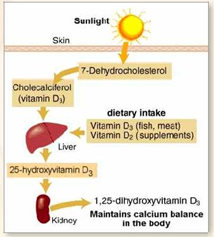Importance of Vitamin D and B12 in Human Body
Vitamin D and B12 Deficiency on the Rise in Corporate Executives
Lifestyle disorders are now also manifesting as deficiency of Vitamin B12 and Vitamin D, the sunshine hormone. A recent study, published in the Indian Journal Of Occupational and Environmental Medicine (IOJEM), estimates the deficiency level of Vitamin B12 at nearly 68% and Vitamin D at about 28% among the executives surveyed [1]
 The IJOEM study assessed the incidence of vitamin B12 and D3 deficiency among company executives by subjecting them to analysis of blood levels of vitamin D (25 Hydroxy Cholecalciferol) and vitamin B12.
The IJOEM study assessed the incidence of vitamin B12 and D3 deficiency among company executives by subjecting them to analysis of blood levels of vitamin D (25 Hydroxy Cholecalciferol) and vitamin B12.
The study targeted corporate executives who
- hadvague complaints of unexplained pain in upper and lower limbs
- worked long hours in air-conditioned offices
- andinspite of living in a city with a tropical climate, were barely exposed to sunlight.
Prevalence rate of Vitamin D deficiency and relation to exercise and exposure to sunlight
The IJOEM study concludes that in spite of living in tropical climates with abundant sunlight, vitamin D3 deficiency is evident in the urban Indian population as a corporate lifestyle disorder. Office executives especially, are not exposed to sunlight due to changing lifestyles, long working hours, modern environment and lack of physical exercise or indoor exercises thus hardly exposing themselves to sunlight.
Prevalence rate of B12 deficiency and relation to diet
High incidence of vitamin B12 deficiency was observed probably due to predominently vegetarian diet and insufficient consumption of dairy products, poultry, meat and alcohol consumption. Alcohol is known to retard the absorption of vitamin B12.
Does vitamin D offer benefits beyond bone health?
 Researchers continue to report on a growing body of evidence that indicates vitamin D plays a much larger role in regulating health than simply helping build strong
Researchers continue to report on a growing body of evidence that indicates vitamin D plays a much larger role in regulating health than simply helping build strong
bones. Vitamin D appears to help regulate cell growth, immunity, musculoskeletal health and various other biological functions that play a role in keeping us healthy (2-5).
A study in the current issue of the Archives of Internal Medicine reports that men with blood levels below 15 nanograms per milliliter had 2 1/2 times the risk of having a heart attack or dying. Follow up period was 10 years in the study and after additional adjustment for family history of myocardial infarction, body mass index, alcohol consumption, physical activity, history of diabetes mellitus and hypertension, low- and high-density lipoprotein cholesterol levels and triglyceride levels, this relationship remained significant.
Another study found that low levels of vitamin D increased the risk of diabetes, and yet another reasearch linked deficiencies to an increased risk of dying from breast cancer.
Sunlight and diet as sources for Vitamin D:
The skin manufactures the majority of the body’s vitamin D by tissue synthesis from cholesterol catalyzed by skin exposure to UV light. But as adults age the ability to make vitamin D through the skin diminishes. Avoiding sun exposure or using sunscreen can also limit a person’s production of vitamin D. Adequate sun exposure is 10-20 minutes for people with pale skin in the summer noonday sun. For others with darker skin tones, the corresponding time is 60-100 minutes. Since the length of time for sun exposure varies with geographical location, skin pigmentation, percent body fat and age, careful attention to obtaining dietary sources of vitamin D and daily supplementation is prudent.
Some researchers have reported that vitamin D intake is often too low to sustain healthy circulating levels of the active form of this nutrient. This is mostly due to unique dietary patterns, such as low milk consumption, vegetarian diet, limited use of dietary supplements or low fish intake.
LPL Tests for assessment of Vitamin D and B12 levels
- 25 hydroxy vitamin D enzyme immunoassay – Vitamin D derived from diet and tissue synthesis is hydroxylated to 25 hydroxy vitamin D. This is the major circulating form of vitamin D. Due to its long half life, the blood levels can be used to assess the vitamin D status of the patients. The levels vary with exposure to sunlight, peaking in summers in ambulatory patients.
- 1,25 dihydroxy vitamin D enzyme immunoassay – This is the bioactive form of the vitamin formed by hydroxylation in the kidney. The process in the kidney is stimulated by parathyroid hormone and hypophosphatemia. These levels are useful in monitoring patients with renal osteodystrophy, chronic renal failure, parathyroid disease and vitamin D dependence or resistance.
- Vitamin B12 Cyanocobalamin chemiluminescent immunoassay (CLIA) – Deficiency leads to megaloblastic anemia, neurological changes including demyelination
Sampling Cautions
- Overnight fasting 2. Sample should be wrapped in aluminium foil to protect from light 3. Avoid vitamin supplements 24 hours prior to sampling
References:
- Incidence of vitamin B12 / D3 deficiency among company executives, Gulvady, Chaitanya; Pingle, Shyam; Shanbhag, Shrinivas; Indian Journal of Occupational and Environmental Medicine, Vol. 11, No. 2, May-August, 2007, pp. 83-85 2. Raiten DJ, Picciano MF. Vitamin D and health in the 21st century: bone and beyond. Executive summary. Am J Clin Nutr. 2004;80:1673S-1677S. 3. Cantorna MT, Zhu Y, Froicu M, Wittke A Vitamin D status, 1,25-dihydroxyvitamin D3, and the immune system. Am J Clin Nutr. 2004;80:1717S-1720S. 4. Montero-Odasso M, Duque G. Vitamin D in the aging musculoskeletal system: an authentic strength preserving hormone. Mol Aspects Med. 2005;26:203-319. 5. Holick MF. Vitamin D: importance in the prevention of cancers, type 1 diabetes, heart disease, and osteoporosis. Am J Clin Nutr. 2004;79:362-371.
FROM THE EDITOR’S DESK
 In this Mega-marathon of life, we sacrifice many vital elements of our being including health. Lifestyle disorders accumulate and small changes manifest as serious ones.
In this Mega-marathon of life, we sacrifice many vital elements of our being including health. Lifestyle disorders accumulate and small changes manifest as serious ones.
Lifestyle disorders have been the neglected stepchild of primary health care and yet contribute to high levels of medical morbidity and clinically significant decrements in function. In this issue we highlight two such recent reports on lifestyle diseases, deficiency of the “Sunshine hormone Vitamin – D”, surprisingly prevalent in a tropical country like ours and Heart disease, high blood pressure and therosclerosis – conditions that are usually associated with the senior population – creeping into young adulthood.
According to recent pharmaceutical research studies prescription drug use by younger adults for heart disease- related conditions, lipid lowering drugs and antihypertensives, is increasing at a rapid rate, far outpacing older adults and offering a glimpse into the forthcoming clinical and financial challenges facing our health care system. The flip side of the story is that younger patients are taking medications to control conditions that, if left untreated, could lead to heart attacks and strokes – indicating that physicians are screening patients more regularly and treating these precursors more aggressively than in the past. Predictors of future risk of cardiovascular disease can help formulate appropriate strategies for screening and treating young men at heightened risk.
Another offshoot of changing lifestyles is increasing maternal age at first pregnancy and consequently increased risk of fetal chromosomal abnormalities. onsidering that an estimated 75 percent of affected fetuses are born to mothers younger than 35 years, it is pertinent to provide pregnant women, younger than 35 years, with noninvasive screening methods. In his article, Dr A. Gupta, details maternal screening methods and first trimester screening – Double Test, recently added to LPL test menu.
It is indeed encouraging to have received a tremendous response to the previous issue of INSIGHT and we continue to look forward to your valuable feedback and suggestions to guide us in addressing the various issues in need of diagnostic service.















